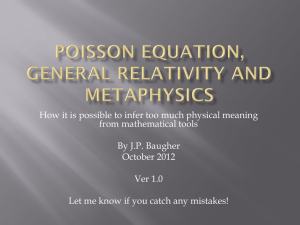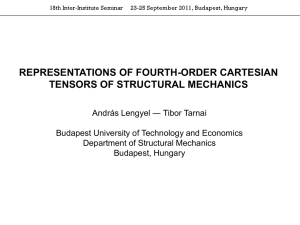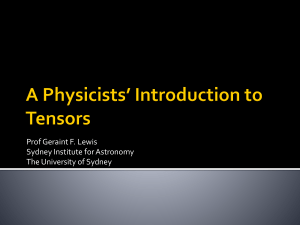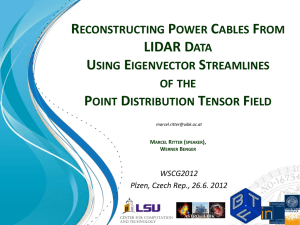Tensor Theory
advertisement
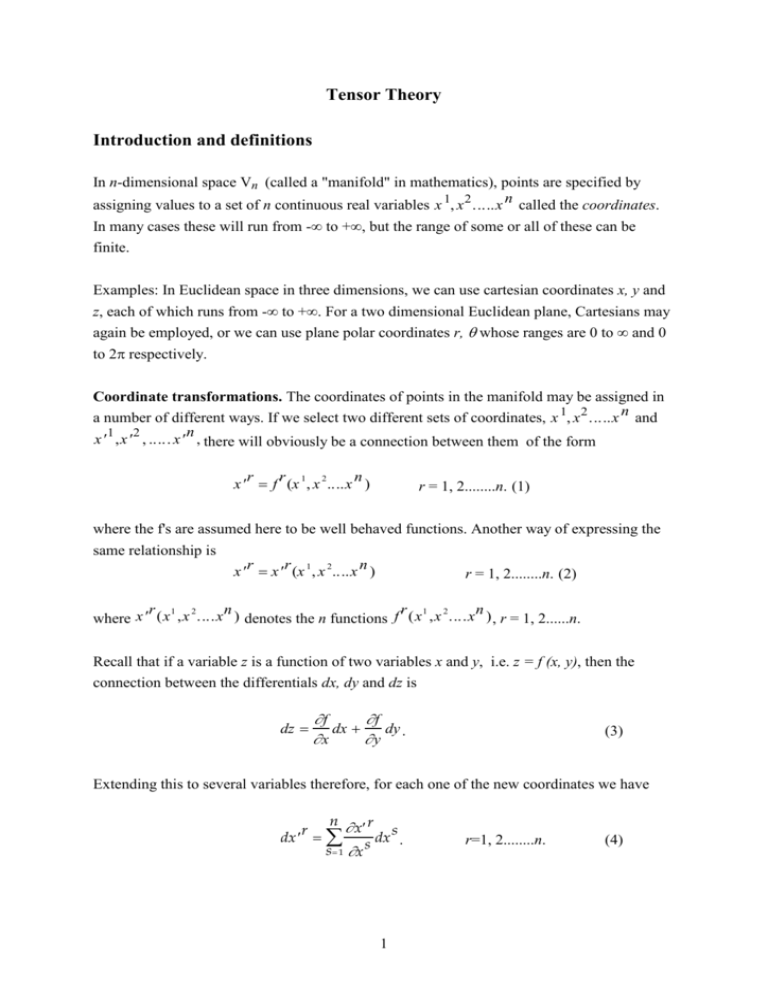
Tensor Theory Introduction and definitions In n-dimensional space Vn (called a "manifold" in mathematics), points are specified by assigning values to a set of n continuous real variables x 1, x 2 .....x n called the coordinates. In many cases these will run from -∞ to +∞, but the range of some or all of these can be finite. Examples: In Euclidean space in three dimensions, we can use cartesian coordinates x, y and z, each of which runs from -∞ to +∞. For a two dimensional Euclidean plane, Cartesians may again be employed, or we can use plane polar coordinates r, whose ranges are 0 to ∞ and 0 to 2 respectively. Coordinate transformations. The coordinates of points in the manifold may be assigned in a number of different ways. If we select two different sets of coordinates, x 1, x 2 .....x n and x 1 , x 2 , ..... x n , there will obviously be a connection between them of the form x r f r (x 1 , x 2....x n ) r = 1, 2........n. (1) where the f's are assumed here to be well behaved functions. Another way of expressing the same relationship is x r x r (x 1 , x 2....x n ) r = 1, 2........n. (2) r 1 2 n r 1 2 n where x (x ,x ....x ) denotes the n functions f (x ,x ....x ) , r = 1, 2......n. Recall that if a variable z is a function of two variables x and y, i.e. z = f (x, y), then the connection between the differentials dx, dy and dz is dz f f dx dy . x y (3) Extending this to several variables therefore, for each one of the new coordinates we have n xr r dx s dx s . s 1 x 1 r=1, 2........n. (4) The transformation of the differentials of the coordinates is therefore linear and homogeneous, which is not necessarily the case for the transformation of the coordinates themselves. Range and Summation Conventions. Equations such as (4) may be simplified by the use of two conventions: Range Convention: When a suffix is unrepeated in a term, it is understood to take all values in the range 1, 2, 3.....n. Summation Convention: When a suffix is repeated in a term, summation with respect to that suffix is understood, the range of summation being 1, 2, 3.....n. With these two conventions applying, equation (4) may be written as r r x s dx dx . (5) x s Note that a repeated suffix is a "dummy" suffix, and can be replaced by any convenient alternative. For example, equation (5) could have been written as r r x m dx m dx . (6) x where the summation with respect to s has been replaced by the summation with respect to m. Contravariant vectors and tensors. Consider two neighbouring points P and Q in the manifold whose coordinates are xr and xr + dxr respectively. The vector P Q is then described by the quantities dxr which are the components of the vector in this coordinate system. In the dashed coordinates, the vector P Q is described by the components dx r which are related to dxr by equation (5), the differential coefficients being evaluated at r P. The infinitesimal displacement represented by dxr or dx is an example of a contravariant vector. Defn. A set of n quantities T r associated with a point P are said to be the components of a contravariant vector if they transform, on change of coordinates, according to the equation r r x s T T . xs (7) 2 where the partial derivatives are evaluated at the point P. (Note that there is no requirement that the components of a contravariant tensor should be infinitesimal.) Defn. A set of n 2 quantities T rs associated with a point P are said to be the components of a contravariant tensor of the second order if they transform, on change of coordinates, according to the equation r s rs x x mn T m n T . x x (8) Obviously the definition can be extended to tensors of higher order. A contravariant vector is the same as a contravariant tensor of first order. Defn. A contravariant tensor of zero order transforms, on change of coordinates, according to the equation T T , (9) i.e. it is an invariant whose value is independent of the coordinate system used. Covariant vectors and tensors. Let be an invariant function of the coordinates, i.e. its value may depend on position P in the manifold but is independent of the coordinate system used. Then the partial derivatives of transform according to xs xr xs xr (10) Here the transformation is similar to equation (7) except that the partial derivative involving the two sets of coordinates is the other way up. The partial derivatives of an invariant function provide an example of the components of a covariant vector. Defn. A set of n quantities T r associated with a point P are said to be the components of a covariant vector if they transform, on change of coordinates, according to the equation T r x s T . xr s (11) 3 By convention, suffices indicating contravariant character are placed as superscripts, and those indicating covariant character as subscripts. Hence the reason for writing the coordinates as xr. (Note however that it is only the differentials of the coordinates, not the coordinates themselves, that always have tensor character. The latter may be tensors, but this is not always the case.) Extending the definition as before, a covariant tensor of the second order is defined by the transformation xm x n T (12) rs x r x s T mn and similarly for higher orders. Mixed tensors. These are tensors with at least one covariant suffix and one contravariant r suffix. An example is the third order tensor T st which transforms according to p x r x n x m r T st xm x s xt Tnp (13) Another example is the Kronecker delta defined by sr 1, r s 0, r s (14) mn.. t It is a tensor of the type indicated because (a) in an expression such as Bpq.. m , which involves summation with respect to m, there is only one non-zero contribution from the mn.. t tn.. Kronecker delta, that for which m = t, and so Bpq.. m B pq.. ; (b) the coordinates in any xr r coordinate system are necessarily independent of each other, so that s s and x r x r s ; so these two properties taken together imply that s x sr xr xn m . x m xs n (15) Notes. 1. The importance of tensors is that if a tensor equation is true in one set of coordinates it is also true in any other coordinates. e.g. if T mn 0 (which, since m 4 and n are unrepeated, implies that the equation is true for all m and n, not just for 0 also, from the transformation some particular choice of these suffices), then T rs law. This illustrates the fact that any tensor equation is covariant, which means that it has the same form in all coordinate systems. 2. A tensor may be defined at a single point P within the manifold, or along a curve, or throughout a subspace, or throughout the manifold itself. In the latter cases we speak of a tensor field. Tensor algebra Addition of tensors. Two tensors of the same type may be added together to give another r r tensor of the same type, e.g. if Ast and Bst are tensors of the type indicated, then we can define Cr Ar Br . (16) st st st r It is easy to show that the quantities Cst form the components of a tensor. rs Symmetric and antisymmetric tensors. A is a symmetric contravariant tensor if Ars Asr and antisymmetric if Ars Asr . Similarly for covariant tensors. Symmetry rs sr properties are conserved under transformation of coordinates, e.g. if A A , then Amn x m xn rs xm x n sr A A Anm . r s r s x x x x (17) s r Note however that for a mixed tensor, a relation such as Ar As does not transform to give the equivalent relation in the dashed coordinates. The concept of symmetry (with respect to a pair of suffices which are either both subscripts or both superscripts) can obviously be extended to tensors of higher order. Any covariant or contravariant tensor of second order may be expressed as the sum of a symmetric tensor and an antisymmetric tensor, e.g. Ars 1 rs 1 (A Asr ) (Ars A sr ) . 2 2 5 (18) Multiplication of tensors. In the addition of tensors we are restricted to tensors of a single type, with the same suffices (though they need not occur in the same order). In the multiplication of tensors there is no such restriction. The only condition is that we never multiply two components with the same suffix at the same level in each. (This would imply summation with respect to the repeated suffix, but the resulting object would not have tensor character - see later.) m To multiply two tensors e.g. Ars and Bn we simply write m Crsn ArsBnm . (19) m It follows immediately from their transformation properties that the quantities Crsn form a tensor of the type indicated. This tensor, in which the symbols for the suffices are all m different, is called the outer product of Ars and Bn . m Contraction of tensors. Given a tensor T np , then m s t m x x x r Tnp p Tst . xr x n x (20) Hence replacing n by m (and therefore implying summation with respect to m) m s t m x x x r T mp p T st xr x m x x s x t r r p T st x x t s x r r p Tst x m xt s T xp st (21) so we see that T mp behaves like a tensor Ap . The upshot is that contraction of a tensor (i.e. writing the same letter as a subscript and a superscript) reduces the order of the tensor by 2 and yields a tensor whose type is indicated by the remaining suffices. Note that contraction can only be applied successfully to suffices at different levels. We may p p of course construct, starting with a tensor Aqrs say, a new set of quantities Aqrr ; but these do not have tensor character (as one can easily check) so are of little interest. 6 m m Having constructed the outer product Crsn ArsBn in the example above, we can form the m m m m corresponding inner products Cmsn AmsBn and Crmn ArmBn . Each of these forms a covariant tensor of second order. Tests for tensor character. The direct way of testing whether a set of quantities form the components of a tensor is to see whether they obey the appropriate tensor transformation law when the coordinates are changed. There is also an indirect method however, two examples of which will now be given: r Theorem 1. Let X be the components of an arbitrary contravariant vector. Let Ar be another r set of quantities. If ArX is an invariant, then Ar form the components of a covariant vector. r r Proof: Since X is a tensor, it obeys the tensor transformation law. Invariance of ArX means that xs r X xr s ArX r A sX As and so xs r (Ar As r )X 0 . x (22) (23) r Hence, since X is an arbitrary tensor, x s Ar As. xr QED (24) As an extension of this theorem, it is easy to show that any set of functions of the coordinates, whose inner product with an arbitrary covariant or contravariant vector is a rs r tensor, are themselves the components of a tensor. For example, if A Xs is a tensor B , then Ars is a second order contravariant tensor. r s r Theorem 2. If arsX X is invariant, X being an arbitrary contravariant vector and ars being symmetric in all coordinate systems, then ars are the components of a covariant tensor of second order. r s Proof: From our assumption about the invariance of arsX X , amnX mX n ars X r Xs x r x s m n ars m X X x x n 7 (25) bmnX mXn (a mn a rs Hence x r x s m n )X X 0 . x m x n (26) m m n Since X is arbitrary and the total coefficient of X X is bmn bnm , we deduce that bmn bnm 0 , i.e. xr xs x r xs a rs xm xn x n x m x r x s (ars a ) sr x m x n amn anm ars (27) on interchanging the summation variables r and s in the second term. But amn anm in all coordinate systems, hence amn a rs xr xs . x m xn QED (28) The metric tensor The Euclidean space. Consider first the familiar Euclidean space in three dimensions, i.e. a space in which one can define Cartesian coordinates x, y and z so that the distance d between two neighbouring points x, y, z and x dx, y dy, z dz is given by d 2 (dx)2 (dy)2 (dz)2 . 1 2 (29) 3 If we choose any other coordinates x , x ,x to identify points in this space, the original coordinates will be functions of these new coordinates, and their differentials will be linear combinations of the differentials of the new coordinates. Thus in terms of the latter coordinates, d 2 amndxm dxn (30) m where the amn will be functions of x . (For example in spherical polar coordinates x 1 r, x 2 , x3 we have a11 1, a 22 r 2 , a 33 r 2 sin2 and all other a's are zero.) We now show that amn is a covariant tensor of second order. The proof goes as follows: (a) amn may be taken to be symmetric since each apq occurs only in the combination apq a qp on the RHS of (30). 8 2 m n (b) d amndx dx is invariant, since the distance between two points does not depend on the coordinates used to evaluate it. (c) By keeping one point fixed and letting the second point vary in the neighbourhood of the r first, dx may be considered an arbitrary contravariant tensor. Hence, using the theorem above, amn is a covariant tensor of second order. It is called the metric tensor for the Euclidean 3-space. A similar tensor obviously exists in the case of a two dimensional Euclidean space. Riemannian space. A manifold is said to be Riemannian if there exists within it a covariant tensor of the second order which is symmetric. This tensor is called the metric tensor and normally denoted by gmn . Its significance is that it can be used to define the analogue of "distance" between points, and the lengths of vectors. We will assume that all manifolds that we will be dealing with from now on are Riemannian. r r r Defn. The interval ds between the neighbouring points x and x dx is given by ds2 gmn dx mdx n . (31) This is of course invariant. In the familiar Euclidean space where gmn is just the amn above, ds2 d 2 0 , being zero only when the two points coincide. In other cases however, e.g. in 2 spacetime in relativity theory, ds may take on negative values, so that ds itself is not r r necessarily real. If ds = 0 for dx not all zero, the displacement dx is called a null displacement. Note that there is no requirement that ds should necessarily have the physical dimensions of length. The conjugate metric tensor. From the covariant metric tensor gmn we can construct a mn contravariant tensor g defined by g mngnp pm . (32) mn p To show that g is a tensor, we note that, for any contravariant vector V , g mngnpV p pmV p V m . This means that the inner product of g mn with the arbitrary p mn m covariant vector gnpV is a tensor, V , and so we deduce that g is indeed a tensor of the type indicated. It is said to be conjugate to gmn . It is easily shown that when the metric 9 tensor is diagonal, i.e. when gmn 0, m n , the conjugate tensor is also diagonal, with each nn diagonal element satisfying g 1/ gnn . The following theorem can be proved, but will just be quoted here: if g is the determinant of the matrix gmn (i.e. choosing to write the components of the tensor gmn in the form of a matrix array), then g mn gmn r ln g . r x x (33) m Raising and lowering suffices. Given a tensor T rs , we may form another tensor T mrs defined by Note that T nrs gnmT m rs g mnTnrs g mngntTtrs tmTtrs Tm rs . (34) (35) The tensor T nrs may therefore be regarded as possessing a special relationship with the m original tensor T rs in that either of them may be found from the other by the operation of forming the inner product of the first with the metric tensor or its conjugate. For this reason, the same symbol is used (T in this instance), and we describe the above processes by saying that in (34) we have "lowered the suffix m", and that in (35) we have "raised the suffix n". The process of raising or lowering suffices can be extended to cover all the indices of a tensor. For example we can raise one or both of the suffices in the tensor T mn , generating m m mn the corresponding tensors T n , T n and T . Notice the distinction between the two forms of the mixed tensor, effected by leaving appropriate gaps in the set of indices. When the tensor is symmetric however this distinction disappears and we simply write either of m these as T n . Cartesian tensors Flat space. A space or manifold is said to be flat if it is possible to find a coordinate system for which the metric tensor gmn is diagonal, with all diagonal elements equal to ± 1, otherwise the space is said to be curved. The familiar Euclidean space in two or three dimensions is obviously flat, the diagonal elements then being all equal to + 1. We normally assume that the ordinary three dimensional space which we inhabit is flat, likewise in the special theory of relativity that the 10 4-dimensional "spacetime" is flat. In the general theory of relativity however this assumption must be abandoned, and we have to deal with the consequences of spacetime being curved. It should not be assumed however that curved spaces never arise in elementary physics or mathematics. Take for instance the surface of a sphere, where it is natural to identify position on the surface by spatial coordinates ( , ) ; these are the second and third members of the set of three spherical polar coordinates (r, , ) , the first one having been set equal to a constant, viz. the radius of the sphere. The expression for the line element on the surface of a sphere is (36) d 2 a 2 (d 2 sin2 d 2 ) where a is the radius of the sphere. No coordinate transformation can be found from ( , ) to new coordinates (x1 , x 2 ) such that the line element can be re-expressed in the form d 2 (dx1)2 (dx 2 )2 (37) and so the space is by definition curved. Of course in this case the result is in accordance with our everyday notions regarding curvature. Geometry in a curved space is intrinsically different from that for flat spaces, e.g. parallel lines do eventually meet, and the sum of the angles in a triangle is not 180o. Homogeneous coordinates. These are coordinates for which the metric tensor is diagonal with all diagonal elements taking the values +1. The metric expression is then ds2 (dx1 )2 (dx2 ) 2 (dx 3 )2 ...... (38) Clearly such coordinates can exist only if the space in question is flat. If this condition is satisfied, it must always be possible to find a set of homogeneous coordinates, since any minus signs in an expression for the metric can be transformed away by re-defining coordinates (albeit with imaginary values) with appropriate factors of i inserted. Cartesian coordinates in the Euclidean plane or the Euclidean 3- space are obviously homogeneous. Orthogonal transformations. These are linear transformations between two sets of homogeneous coordinates, x m and x m of the form x m Anm xn Am 11 (39) where the coefficients Anm and Am are constants. Since the set x m are homogeneous, But, from (39), and so ds2 dx mdx m . (40) dx m Anm dxn (41) n m p ds2 Am n dx Ap dx . (42) But the coordinates x m are also homogeneous, and so the RHS of (42) is required to be equal to dx p dx p . Hence n p AnmAm (43) p dx dx which requires Anm Apm 1 , n = p = 0, otherwise (44) Cartesian tensors. If we are dealing with a flat space, homogeneous coordinates are an obvious preferred choice since they facilitate geometrical calculations. Any change of coordinates will normally involve orthogonal transformation equations satisfying equation (39). It is convenient therefore to define Cartesian tensors as quantities which transform according to the usual tensor transformation equations when the coordinates undergo an orthogonal transformation, i.e. as we pass from one set of homogeneous coordinates to another. Note carefully that orthogonal transformation equations are a subset of all possible transformation equations. Therefore "Cartesian tensors" will not in general obey the tensor laws when subjected to an arbitrary coordinate transformation. On the other hand any (unrestricted) tensor automatically satisfies the definition of being a Cartesian tensor, since the conditions for the latter are a subset of the conditions for the former. We therefore have the seemingly paradoxical statement that "all tensors are Cartesian tensors, but not all Cartesian tensors are tensors". Consider now the inverse transformation equations for an orthogonal transformation. Starting from (39) in the slightly modified form p m x m Am p x A , 12 (45) we have p m m Anmxm AnmAm p x An A (46) m x n Am nA (47) using (44). So the inverse equations are m n x n Am n x A where An AnmAm . (48) (49) The whole point of this analysis is now revealed: from equations (39) and (48) we see that xm xn m An , Anm . n m x x (50) The two differential coefficients involved in these equations are therefore equal; but we see, looking back at equations (7) and (11), that it was the presumed difference between them which was the whole basis of the distinction between covariant and contravariant tensors. Therefore if we restrict ourselves to Cartesian tensors, the distinction between covariant and contravariant tensors disappears, and there is no reason to continue to differentiate between indices used as superscripts and those used as subscripts. For convenience, subscripts are almost invariably the preferred choice in practice. For example, in solid state physics we may require to calculate the electrical conductivity of a metallic crystal. In an isotropic medium such as a polycrystalline material the conductivity equation ji Ei relates the components of the current density j to the components of the electric field E, with the conductivity taken to be constant. But in a single crystal the general relationship would be expressed as ji ijE j where ij is the conductivity tensor and the usual summation convention applies. In most textbooks on such topics the underlying assumption that the crystal or other system under consideration is embedded in a flat space is taken for granted, and Cartesian tensors are automatically implied by the choice of a Cartesian coordinate system. N C McGill 13
